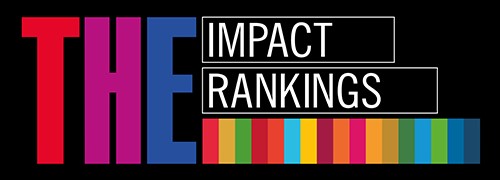Study Innovation and Development Unit
The Study Innovation and Development Unit combines two lines of action: study quality assurance and the introduction of pedagogical innovations. The improvement of study quality includes support for the development of new study programmes and the accreditation of existing study directions, as well as regular and systematic analysis of data on the study process at RSU—the learning experience of students and the pedagogical practice of academic staff. Pedagogical innovations focus on the introduction of new learning and teaching strategies and methods to strengthen the student-centred approach in education, promote the implementation of evidence-based good practice, and improve study quality.
Functions of the unit
Accreditation and licensing
The Study Innovation and Development Unit coordinates the accreditation of study programmes and supports the development and licensing of new programmes. In the development of new programmes, experts from the Centre for Educational Growth (CEG) support the programme director in formulating and mapping learning outcomes to ensure that the programme content and methods comply with the planned learning outcomes. Support for the licensing and accreditation of study programmes is provided by planning and coordinating the preparation of documents, assessing their compliance with external quality requirements, compiling information submitted by different departments, and contributing to the preparation of self-assessment reports for study programmes and directions.
E-learning content
One of the functions of the Study Innovation and Development Unit is to support university academic staff in developing e-learning content that meets RSU’s quality standards. Enhancing e-learning content strengthens an efficient asynchronous study process, allowing students to learn independently at their own pace and location.
Key activities include:
- Advising academic staff on selecting and applying the most appropriate pedagogical methods.
- Organising continuing education activities on the use of digital tools.
- Improving the interactivity of the e-learning environment.
- Developing guidelines and methodological materials by collecting examples of good practice.
- Providing guidance on creating an effective e-learning environment for study courses.
Introduction of innovation
The CEG plays an important role in the identification, evaluation and introduction of pedagogical innovations at Rīga Stradiņš University. One of the important aspects in the introduction of innovations is the digitisation of the study process and the integration of education technologies into the pedagogical activity of the academic staff. Digital solutions include digital tools for a wide range of purposes, such as promoting student activity in face-to-face and online studies and implementing a simulation-based educational approach in the learning process. However, alongside the introduction of digital solutions, special attention is also being paid to the institutional development of academic integrity. To ensure that the innovations planned and introduced are sustainable, advisory support is offered to academic staff and representatives of academic departments, explaining the meaning, importance and applicability of innovation.
Research supports the introduction of innovations by analysing their application, effectiveness and impact on the learning process. To broaden the vision, the CEG participates in local and international projects, facilitating the mobilisation of resources for the introduction of pedagogical innovations and the improvement of the quality of studies. Participation in various research projects not only facilitates the exchange of experience but also strengthens the analysis of RSU’s pedagogical environment. This analysis considers multiple dimensions and is enriched by comparisons with international experiences.
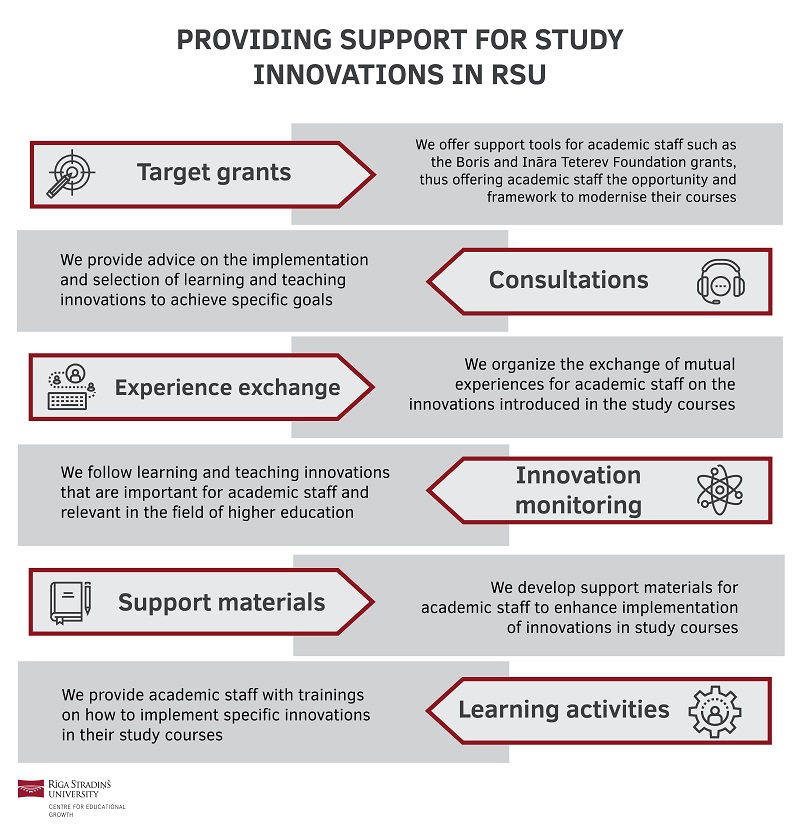
Consultations and support material for academic staff
Pedagogical support materials are developed based on topics relevant to RSU academic staff and current trends in pedagogical innovation. These materials provide both a conceptual explanation of RSU’s pedagogical philosophy and practical methodological suggestions to support academic staff in their teaching. Academic staff can also receive consultations on the topics covered in the support materials, as well as other pedagogical issues relevant to the study process.
Updates on higher education and insights from the work of the CEG can be found on the CEG Facebook page. The Study Innovation and Development Unit also runs a dedicated series of articles every Wednesday, offering practical ideas to support academic staff in planning and delivering their courses. These articles are tagged with the hashtag #PedagoģijasPadomiDocētājiem.
Support materials for academic staff developed by the SEG are available in the RSU Study Material Repository.
Analysis of the quality of the study process
The improvement of study programmes at RSU is based on monitoring process results and conducting a thorough analysis of study data. To ensure systematic quality monitoring, the CEG has developed quality criteria and indicators for study programmes. These criteria reflect descriptive indicators at three levels: institutional, content, and individual. The Study Innovation and Development Unit monitors, collects, analyses, and presents these indicators and their development trends to RSU staff and management. Monitoring data and quality indicators are also used to assess the impact of pedagogical innovations and target initiatives in the context of improving the quality of studies.
Analysis of the RSU study process
One important tool in the analysis of the content of study programmes is the mapping of learning outcomes, which helps assess the alignment of learning outcomes at the study programme and course levels. The Study Innovation and Development Unit supports study programme directors in the mapping process by organising workshops and consultations on mapping learning outcomes.
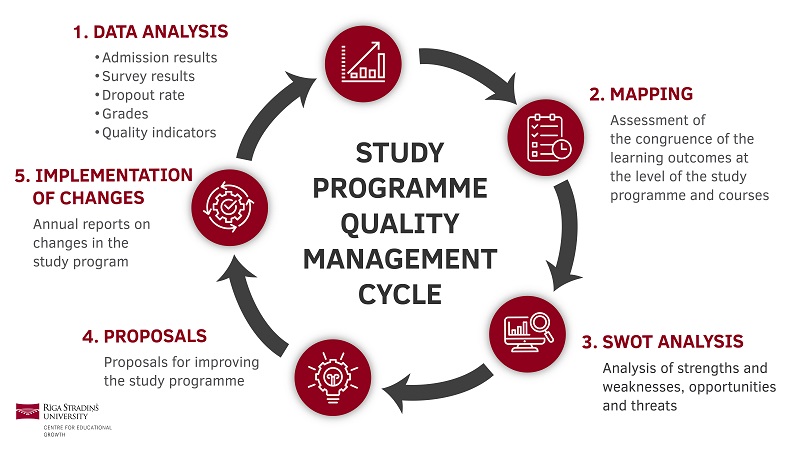
Modernisation of the study process and pedagogical innovation
The Centre for Educational Growth (CEG) continuously assesses the quality of the study process and identifies current needs, promoting the introduction of innovations and supporting academic staff in improving pedagogical practices. The Centre strengthens the student-centred approach to ensure a high-quality study process for future professionals. The modernisation of the study process and pedagogical innovations are implemented in close cooperation with academic staff, students, and colleagues from other departments.
Academic integrity
To promote coherence with the fundamental principles of ethics and academic integrity and ensure their observance in Latvia, the CEG collaborates with other higher education institutions in the country. It develops shared materials, organises seminars, facilitates the exchange of ideas, and engages in problem-solving not only within the University but also at the national level.
To strengthen academic integrity and governance, the CEG has developed support materials for academic staff and students, as well as the RSU Academic Integrity Policy. This policy includes explanations of academic integrity, its violations, examples, procedures for addressing violations, and possible actions in cases of breaches.
To ensure compliance with academic integrity and support academic staff in reviewing student papers throughout the study process, RSU uses the Turnitin tool to check the originality of content. This tool is integrated into the RSU e-learning environment for ease of use. The CEG regularly organises training for academic staff on how to use Turnitin and also encourages the sharing of experiences among faculty members.
Active learning
Active learning is understood as a strategy in which students are encouraged to engage purposefully in the learning process to enhance their cognitive performance and reflect on the learning experiences they gain. In this process, academic staff guide and support students in their inquiry, problem-solving, and subjective discovery of new knowledge. This approach ensures that students play an active role in their learning, allowing them to engage deeply rather than simply passively listening to the academic staff.
Active learning can be promoted both during lectures and classes and through independent student tasks, which develop students' self-directed and self-regulated learning skills.
Learning and Teaching Methods are a defined learning pathway consisting of sequential learning steps, sometimes with the option to reverse or repeat steps. These methods guide students toward achieving the desired learning outcomes. They help students immerse themselves in the content, maintain focus during lectures and classes, and develop transversal skills such as critical thinking and digital literacy.
Learning and Teaching Techniques are activities undertaken by students to optimise the perception, recall, retrieval, and use of information. These strategies strengthen independent learning skills, helping students find and understand complex information more effectively.
To create an enriching learning experience, we recommend incorporating short active learning activities every 20-30 minutes during lectures. These activities could include conceptualisation, reflection, retrieval practice, and other engaging tasks.
The CEG has compiled over 240 learning and teaching methods and techniques in one place as support material.
Updating the content of the e-learning environment
The regularly updated Moodle e-learning environment, which is closely integrated with RSU's study management systems, is used not only for the development and distribution of study materials, but also for communication, collaboration, study support, the administration of independent assignments, and knowledge testing. It also ensures the registration of student attendance, tracks activity, and stores assessment data in the database. The RSU e-learning environment provides access to all study courses included in all RSU study programmes.
The use of the e-learning environment offers significant benefits for all parties involved by improving the efficiency of the study process.
Academic staff can:
- Organise the study process according to their chosen teaching approach;
- Flexibly adapt materials and support to the study format—face-to-face, blended, or distance learning;
- Prepare and publish information relevant to students;
- Develop and update e-learning materials at a convenient time and location;
- Integrate open-access electronic resources and interactive educational tools from the RSU Study Material Repository or other universities;
- Create interactive H5P multimedia learning materials that promote student engagement, including interactive videos, multimedia presentations, and branching scenarios;
- Manage the submission, registration, and grading of assignments and provide timely feedback;
- Assess student knowledge using question banks and tests, and provide fast, fully or semi-automated feedback;
- Automatically check the originality of student submissions thanks to Turnitin integration;
- Record lectures and online seminars through the integration of Panopto and Zoom with Moodle;
- Facilitate group collaboration and manage peer assessment easily;
- Generate reports on student activity and learning outcomes;
- Survey students and evaluate the learning process.
Students can:
- Access study materials in the e-learning environment at any time using a variety of devices;
- View lecture and seminar recordings via Panopto, using the instructions provided in each course;
- Collaborate in group assignments and store shared materials in the digital environment;
- Submit independent work and receive feedback;
- Track their learning progress and view assessment results;
- Contact academic staff and other participants in the learning process via email or other communication tools available in the environment, as well as participate in discussions.
The administration can:
Access reports on student activity and learning outcomes;
Receive information on the quality of materials uploaded and activities within courses;
Collect and review data from student surveys.
Guidelines for E-learning Content (in Latvian)
Course Content in the E-learning Environment (in Latvian)
Study Course Structure in the E-learning Environment (in Latvian)
Instruction: Creating and Using Attendance Activity in Moodle (in Latvian)
School of Junior Academics
Special support is provided to junior academic staff at RSU through the School of Junior Academics. The aim of the School is to support early-career academic staff in developing their pedagogical competence, managing the teaching and learning process, and strengthening their professional skills in working with students. The School of Junior Academics promotes the successful integration of new academic staff into teaching roles, as well as their academic career development at RSU.
AI in higher education
AI solutions are among the most impactful digital technologies in higher education today. Experts at the CEG closely follow developments in AI and explore the opportunities it offers for enhancing the higher education landscape. The rise of generative AI tools with open access has marked a shift, making sophisticated technologies widely accessible.
The impact of AI in higher education goes beyond the introduction of new learning tools or changes to teaching methods. It creates opportunities to improve students’ academic performance and provide more individualised learning environments. At the same time, AI introduces challenges and risks—such as the generation of incorrect or misleading information, threats to academic integrity, the reinforcement of biases, and unequal access to digital tools. These concerns call for a unified approach and contributions from both academic staff and higher education policymakers.
In line with RSU’s Artificial Intelligence Guidelines, the University seeks to meaningfully integrate AI tools into the study process. This includes using AI not only for content creation and adaptation, but also for assessment, learning analytics, and more. All solutions are introduced with a focus on supporting student learning, strengthening academic integrity, and contributing to the quality of the study process.
Research-based learning
The European Commission recognises that research and innovation play a vital role in addressing societal challenges, and that effective higher education institutions are essential in this process. At the same time, new approaches are needed to integrate research into the study process and to involve students more actively, helping them understand contemporary challenges and develop their research skills. International studies show that incorporating research into the study process enhances the role of higher education institutions in society and fosters collaboration with both the public and private sectors.
As noted in Forbes (Rosowsky, 2022), “Research on timely and important topics attracts attention, which in turn leads to greater institutional visibility and reputation. As a university becomes known for its research in certain fields, they become magnets for students, faculty, grants, media coverage, and even philanthropy. Strength in research helps to define a university’s ‘brand’ in the national and international marketplace, impacting everything from student recruitment, to faculty retention, to attracting new investments.”
Research and teaching quality are closely interconnected. Students tend to have a more positive perception of academic staff who are research-active. Involvement in research enhances the learning environment by helping students connect theoretical ideas with scientific inquiry. It also contributes to stronger academic outcomes, as students develop critical thinking, scientific reasoning, and a positive attitude towards research across their study courses.
In summary, a high-quality study process that incorporates research not only supports student development but also strengthens the reputation and societal impact of the higher education institution.
Skills monitoring
The CEG supports the development and integration of a skills management system into the study process, enabling a qualitative assessment of learning outcomes and facilitating comparison across educational institutions and countries. This skills monitoring system ensures the comprehensive management of skills throughout the entire study process at Rīga Stradiņš University—from identifying skills and incorporating them into the study programme to issuing a certificate of acquired skills (a student skills portfolio) upon graduation.
By implementing systemic skills management, the University can more flexibly align with the skills required by the labour market. Administrative staff benefit from a more streamlined planning and systems management process, academic staff gain access to a shared methodology for organising and evaluating skills training, and students receive a portfolio that documents their professional skills and enhances their competitiveness in the labour market.
Skills Monitoring in Healthcare Studies – For Patient Safety and Healthcare Quality
The skills monitoring system at Rīga Stradiņš University includes:
- a Skills Catalogue, which describes skills performance and structured, objective assessment criteria, aiding the planning of skills acquisition;
- a methodology for skills acquisition, defining how specific skills should be learned;
- criterion-based, structured assessment of skills, including the development of digital assessment tools;
- a skills portfolio, which documents all the skills a student has acquired and the levels of mastery achieved.
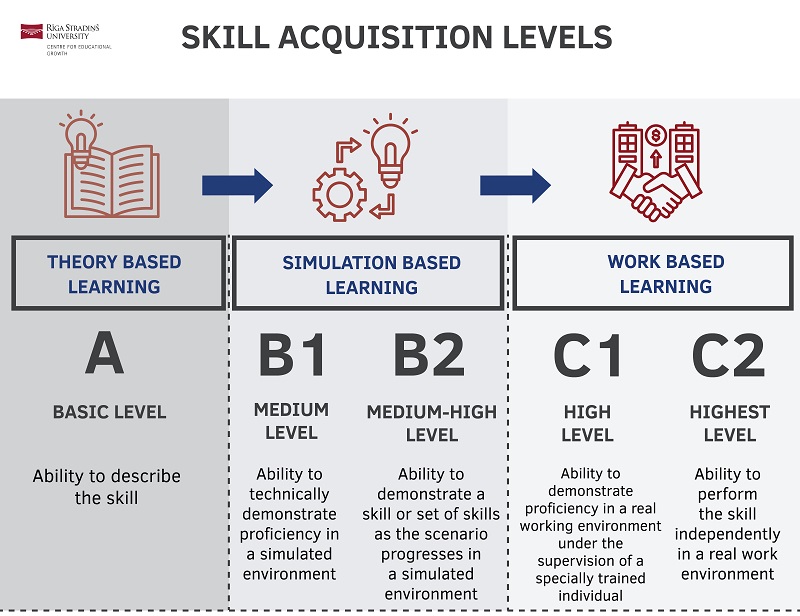
The development of the skills monitoring system was supported through the ESF project Improvement of the management process and study content modernisation at Rīga Stradiņš University (Project No. 8.2.3.0/18/A/011).
Simulation-based education
Simulations in education are structured representations of real-life activities with clearly defined goals. They allow students to practise and apply practical skills within a digital environment—enabling them to influence the course of a situation, perform procedures, and receive automated feedback aligned with the simulation's objectives.
Both tangible objects that interact in a digital environment and real-life processes or professional tasks can be simulated. These digital simulation tasks are scenario-based and aligned with learning objectives, helping students concentrate on real-life situations as modelled by the simulation (Holt et al., 2012).
Through simulations, students have the opportunity to acquire and develop skills relevant to their future profession by immersing themselves in diverse scenarios and working with virtual tools and materials. Digital simulations can be conducted:
- on a computer screen (in a two-dimensional or pseudo-three-dimensional environment),
- in augmented reality (AR), or
- in virtual reality (VR).
These tools provide a safe and interactive space for experiential learning, supporting the development of competencies needed in professional practice.
Study analytics
One of the areas of expertise of the CEG is supporting academic staff and study programme directors in evaluating and enhancing the internal coherence of study courses within programmes. This process includes setting goals, formulating learning outcomes, planning learning activities, and selecting the types of assessment that most effectively evaluate a student’s ability to demonstrate their acquired knowledge and skills.
This process is guided by the principles of "backward design", which begins with clearly defining the desired outcomes of a course. The next step involves selecting the most appropriate assessment methods to measure these outcomes, followed by planning the learning activities accordingly. The focus is on formulating learning outcomes that are observable, measurable, and achievable within the allocated time for each course or programme. This approach ensures that course content is derived from the programme’s overarching goals and intended outcomes, ultimately enhancing quality, effectiveness, and student-centredness.
To support this, the CEG has developed a learning outcomes mapping tool, which enables the review of course and programme learning outcomes. This tool helps assess their alignment with regulatory requirements and principles of student-centred learning. It also identifies whether, and how, students are enabled to achieve programme-level outcomes through the sequential completion of specific courses. This mapping process is essential for programme analysis, quality assurance, and continuous improvement of the study process.
The CEG also plays a crucial role in gathering and analysing student feedback at both course and programme levels. It collects and evaluates data from student surveys conducted across the University, providing insights into student satisfaction with academic staff, programme choices, and other key areas. While the CEG handles institutional-level analysis, detailed reviews are conducted at faculty level by programme directors, heads of departments, and course leaders. The Centre also analyses feedback from graduates and employers to offer a comprehensive perspective on how well programmes align with labour market demands.
In addition, the CEG is responsible for the development and calculation of Key Performance Indicators (KPIs). These include metrics such as programme demand, student satisfaction, drop-out and graduation rates, and employer feedback. Experts at the CEG define the methodology and benchmarks for these indicators and analyse trends across study programmes. This evidence-based approach helps identify areas for improvement and supports a culture of continuous quality enhancement. The data is used in both internal quality assurance processes and external evaluations such as accreditation, higher education quality monitoring, and university rankings.
Study course design
Learning design refers to the planning, creation and management of activities within a study course or programme. At the CEG, we support academic staff in implementing flexible, innovative learning strategies to enhance the quality of education, support the diverse needs of students and reduce drop-out rates.
To ensure that learning and teaching innovations are meaningful and sustainable, we focus on several essential characteristics during their introduction (A.M. Valders):
- Novelty – This involves introducing new methods of learning and teaching that differ from established practices. It requires an investment of time and effort in researching the current situation, selecting appropriate solutions, and planning the study process accordingly.
- Change – The implementation of innovations that modify how a course is delivered. Whether large or small in scale, such changes are transformative when they respond to the needs of the educational context and current developments at global, national, institutional or programme level.
- Improvement – Innovations are intended to make study courses more student-centred, comprehensible and engaging, thereby improving the overall quality of the learning experience.
- Reflection guides the choice and evaluation of innovation. It is based on the analysis of students’ learning outcomes, feedback received by academic staff, and the academic staff’s own pedagogical reflection on the study process. This includes concepts already familiar to academic staff regarding the implementation of the study process (such as the roles of academic staff and students, the learning process, etc.), as well as the study of trends and current developments in pedagogy.
- Technology – It is vital to explore how digital tools and platforms can enhance the pedagogical process and student engagement.
- Application – Effective implementation of innovations requires prior research, acquisition of relevant skills, and adaptation to the specific needs of the course and the academic’s pedagogical style. This also involves introducing students to the new methods and addressing any unexpected challenges.
- Human aspects – the development of one's own pedagogical practice through active learning by academic staff, experimentation with new methods, and testing new forms of collaboration (in addition to the aspects mentioned in the six previous paragraphs). The introduction of innovations can bring great professional satisfaction and positively influence academic staff’s attitudes towards their teaching practice, collaboration with students, and the study process as a whole.
Guidelines for learning and teaching innovations
Learning design is grounded in the aims of the study programme, the intended learning outcomes of each course, and the chosen teaching and learning methods, techniques, and activities. It also involves selecting appropriate forms of learning organisation, which define how interaction between teachers and students occurs. These can be:
- Face-to-face or online
- Synchronous (students and academic staff are present at the same time)
- Asynchronous (students and academic staff engage with the material at different times)
A combination of synchronous and asynchronous, face-to-face and online activities is known as blended learning. Blended learning makes it possible to better meet students’ individual needs, adapt to contextual constraints, and more effectively achieve learning outcomes.
There are six recognised forms of learning organisation:
- Synchronous face-to-face learning – Teaching takes place in a shared physical environment, with all students present at the same time.
- Asynchronous face-to-face learning – Students independently acquire knowledge or practise skills in a physical setting, using the resources and equipment available.
- Synchronous online learning – Teaching occurs in an online environment, with all students participating simultaneously.
Support material: Tips for students – "How to study remotely"
- Asynchronous online learning – Students access learning content online at their own time, place, and pace.
- Hybrid studies – Some students participate in person while others join remotely, with all learning happening simultaneously.
- Flipped learning process – Students engage with the study content independently before the class. Class time is then used for interactive learning methods that reinforce and apply the content.
Assessment of learning outcomes
Student-centred learning and teaching approaches are based on the idea that students take greater responsibility for achieving learning outcomes, while academic staff recognise and respect students' diverse learning needs and abilities. Within this process, the assessment of learning outcomes is a key tool for understanding how each student is progressing in the study course.
In a student-centred learning environment, the main purpose and benefit of assessment is to reinforce learning. This means that the types of examinations integrated into the study course are not merely mechanical or diagnostic tools, but indicators of the student’s development. To ensure gradual and learning-oriented assessment, RSU places emphasis on cumulative assessment. Assessment is not only a checkpoint before the next topic, but also a continuous exchange of feedback between academic staff and students. This dialogue helps both parties understand how to guide learning going forward. It is important that students develop a deep understanding of any assessment they receive, as this encourages them to engage in learning activities, set personal academic goals and work towards achieving them.
Peer Assessment is one way of deepening students' understanding of assessment. It not only changes the form of cooperation among students, but also significantly strengthens the development of skills in reflection, self-assessment and skills for giving and receiving constructive feedback. By assessing the work of their fellow students, students gain insight into the different strategies, content nuances and quality criteria of the work, enriching their understanding of the content they are studying. Peer assessment skills will also be useful for students in the future when analysing and providing feedback on the work of colleagues in the professional environment.
Engaging students in peer assessment involves more than developing quality assessment criteria or rubrics that focus on the purpose of the assessment. It also includes cultivating an environment of respectful, constructive feedback. For feedback to be heard and received productively, the feedback provider should consider the following:
- Timeliness in offering feedback
- Maintaining focus on the assessment aims
- Explaining rather than judging
- Balancing critical and positive comments
- Ensuring relevance to the recipient’s knowledge, skills and learning objectives
- Respecting the recipient’s autonomy in completing their work
Recommendations for giving and receiving feedback
At the RSU CEG, we aim to foster a learning environment that supports continuous learning, reflection and collaboration. This approach not only supports students in achieving academic success but also helps them develop essential skills for their professional and personal lives.
Technology-enhanced learning process
RSU offers a range of activities to support the organisation of online examinations. Electronic examinations can be used for both formative and summative assessment. There are several advantages to organising examinations online, including flexibility for students to complete them at any time, the ability to take exams remotely, clear control of deadlines, and the opportunity to collect and analyse data.
RSU guidelines for organising electronic examinations
Video lectures are widely used at RSU, allowing students to engage with study content online and strengthen specific knowledge or skills. These may take various forms, such as recorded lectures, laboratory work instructions, audiovisual graphic presentations, or thematic educational films. It is essential that these educational videos are well designed in terms of both content and technical quality—including good framing, adequate lighting, a clear image of the academic staff, and high sound quality. These factors enhance the learning experience, improve comprehension, and provide students with a more engaging and professional impression of the learning process.
Guidelines for creating video materials
Using short video lectures in the learning process
How to view Panopto attendance
Inserting a Zoom link in an e-learning course
The use of digital tools in the study process promotes interactivity in both online and face-to-face settings. A wide range of tools is currently available to support learning and teaching, with various functionalities that help to achieve diverse educational goals and outcomes.
Technology-enhanced study process. Digital tools in seven categories
Study Innovation and Development Unit
Related news
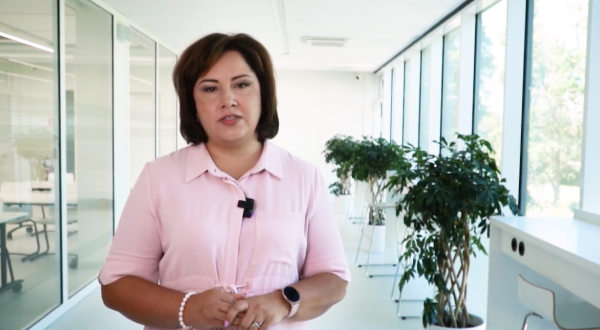 Sustainability as an integral part of the learning process: a lecturer’s experienceSustainable Development, Pedagoģiskā izaugsme
Sustainability as an integral part of the learning process: a lecturer’s experienceSustainable Development, Pedagoģiskā izaugsme School of Junior Academics: the power of peer learning and innovation in teachingPedagoģiskā izaugsme, For RSU Employees, School of Junior Academics
School of Junior Academics: the power of peer learning and innovation in teachingPedagoģiskā izaugsme, For RSU Employees, School of Junior Academics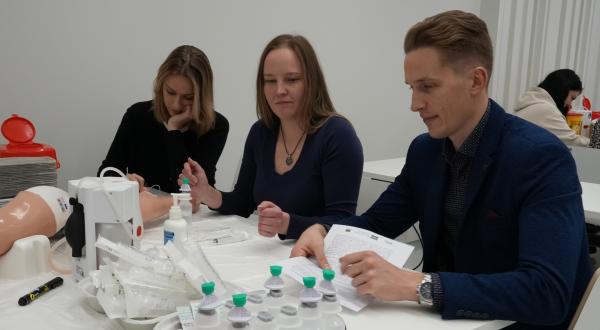 Erasmus+ SkillTrack project has concludedPedagoģiskā izaugsme, International Cooperation
Erasmus+ SkillTrack project has concludedPedagoģiskā izaugsme, International Cooperation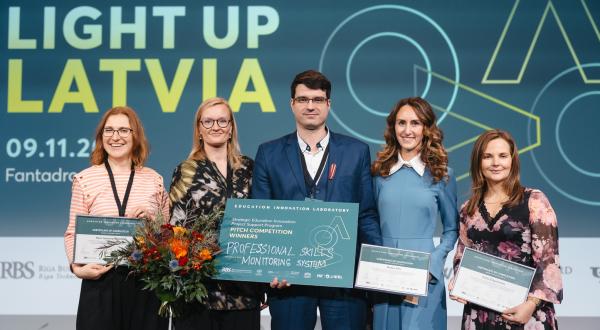 RSU project ‘Professional Skills Monitoring System’ recognised as best at Light Up Latvia conferencePedagoģiskā izaugsme, Development
RSU project ‘Professional Skills Monitoring System’ recognised as best at Light Up Latvia conferencePedagoģiskā izaugsme, Development RSU develops projects to innovate study process in collaboration with the Massachusetts Institute of TechnologyPedagoģiskā izaugsme, Development, International Cooperation
RSU develops projects to innovate study process in collaboration with the Massachusetts Institute of TechnologyPedagoģiskā izaugsme, Development, International Cooperation









